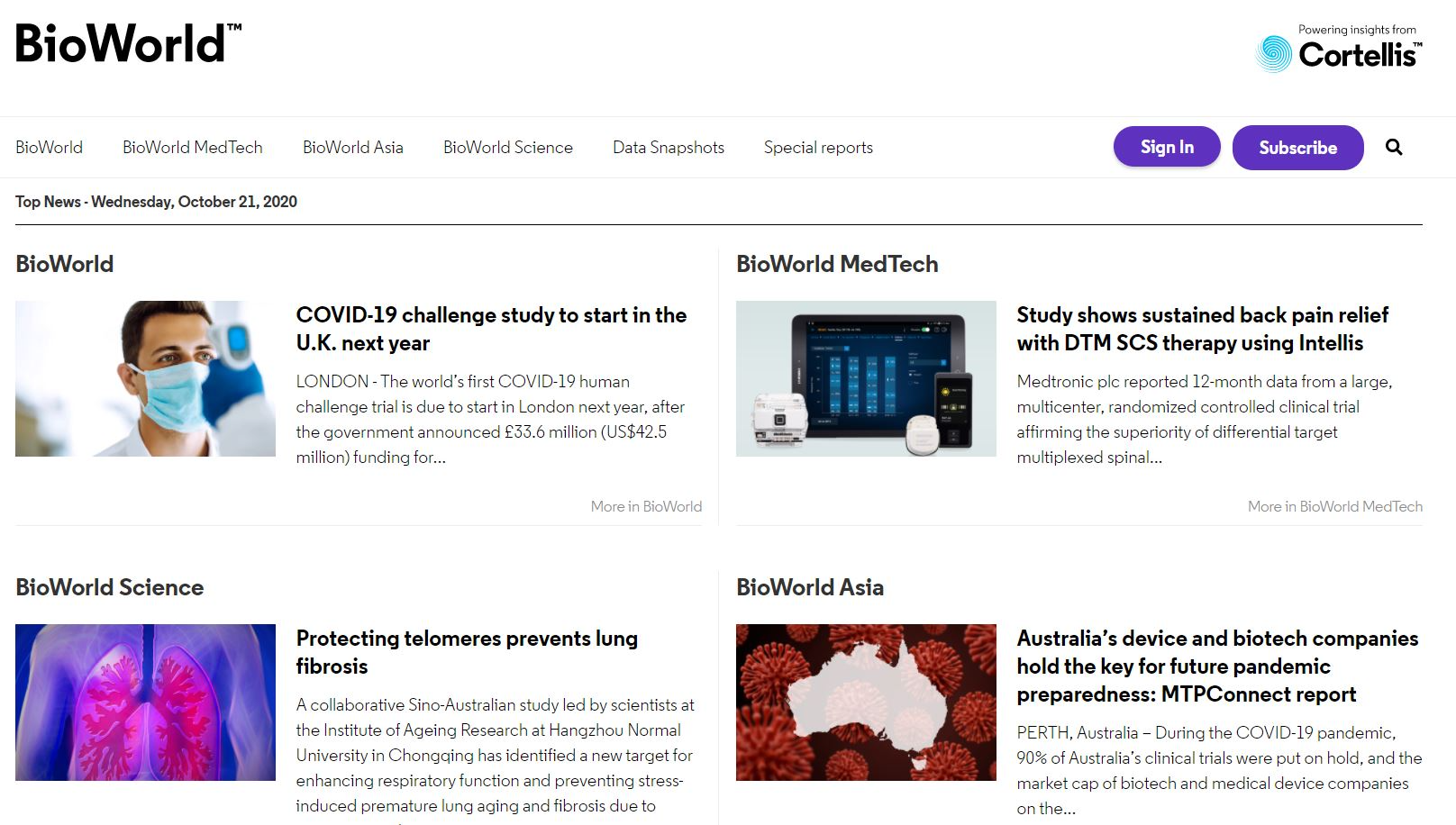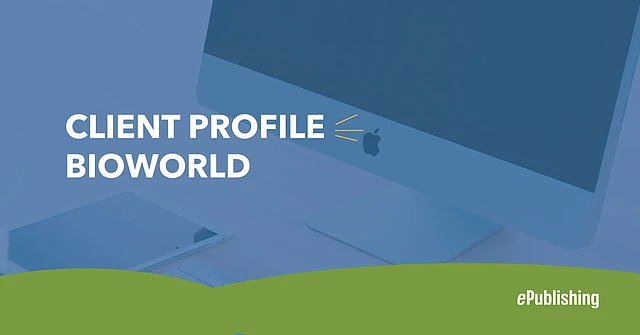How Bioworld Centralized Brands on One Site – and Grew Revenue, Pageviews & Visitors
As of Friday, May 5, 2023

Q&A with Lynn Yoffee, Publisher of Bioworld
We had the privilege of speaking with Lynn Yoffee, publisher of BioWorld, a group of news services focused on the development of drugs and medical technologies. BioWorld migrated to ePublishing’s CMS in 2019, completing their journey to consolidate brands, encourage cross sales, move from next-day to same-day news delivery, and transition away from PDFs to get more readers on site.

As a result, they’ve seen significant increases in their revenue (10%), page views (200%), organic search traffic (20%) and number of site users per day (10X). And they’ve dropped PDFs to go entirely digital. We spoke with Yoffee about the experience of migrating to a new platform, including the benefits, obstacles and lessons they can share with other publishers.
ePublishing: Tell us about BioWorld.
Lynn Yoffee: BioWorld is part of Clarivate. The company helps organizations make decisions through databases and information services in the areas of science and intellectual property. BioWorld covers the development of innovative drugs and medical devices, including the complete lifecycle of thousands of products in development from around the world.
Our mission is to cut through the clutter and deliver focused news to help our customers. We have been around for 30 years and remain committed to core principles of ethical journalism and producing fact- and data-based news and analysis. There are so many pop-up news organizations these days, especially on social media, including free aggregated news. But we've built a trusted relationship with our customers because this is our area of expertise covering complicated topics.
ePublishing: The BioWorld site is editorial-driven. What does that mean to you and how has that affected the way you’ve built the website?
Yoffee: Content rules. Everything we do should be focused on our customers’ information needs, and that's how we've built our business. The editorial team happens to be closest to our customers, so it makes sense that they drive our strategy.
Our business, sales, marketing and technology colleagues are all critical team players, too. It's a group effort to build our strategy, this platform and how we do business day to day. But, when we were developing a plan for the site, creating the actual design and user experience, it was mostly the editorial team driving that. I formed a team from the editorial staff to guide how the pages should be set up, what should be highlighted or deprioritized; they advised on the whole user experience. All this is based on what we know our customers want and our efforts to do better than our competitors.
For many other publishing companies, it seems to be the opposite strategy: Building a new platform is typically driven by the marketing and business teams, then they set up editorial calendars that drive content.
ePublishing: How did you get your editorial team to embrace and act on data and analytics in developing the website and content?
Yoffee: We were doing data before data was cool. We’ve been gathering, tracking and analyzing data for three decades. To produce the news stories we do, it's important to understand the history behind them. For example, if you're developing a story about a new therapy for leukemia, you can report on the latest news, for example say company A has developed a new drug, they're in final-phase trials and presenting their drug trial data. To present a story that gives our readers perspective, we need data to help them understand where this new leukemia drug fits in the whole disease landscape.
You have to look at other key players: What drugs are already out there, how those drugs function, who they serve, how much they cost, how many other companies are developing drugs for leukemia, who's investing in those companies.
It can take north of $1 billion over 10 years to bring a new drug to market. We track the financing trends, who's investing in what, why and how.
Data is critical to our customers. They want proof. So, there was no need to convince the writers; they're already used to it.
And though we’ve always had the data, it was presented in a static format. We wanted to ensure that a new platform would facilitate better presentation – fancier, more eye-catching charts and graphs. ePublishing allowed for that, so we adopted Infogram, which is a third-party program we incorporate with ePublishing as our data visualization tool.

ePublishing: What other reasons did you have for switching platforms, and what features were you looking for?
Yoffee: Our news services lived on several separate platforms with technology that was old and unsupported. We had to do something. We also had a number of goals in mind. It’s not as simple as moving everything to a new website. We took it very seriously and developed a long list of priorities and missions we wanted to accomplish.
The first priority was brand consolidation. Most drugs and medical technologies these days address the same diseases and conditions, and there's increasing crossover and coordination between the pharmaceutical and medical technology industries. This was an opportunity to pull everything together on one platform to display the news across all customer groups with the hope that it would increase our prospects for cross sales.
For example, we noticed one giant pharmaceutical company was subscribing to our medical technology news service, BioWorld MedTech. That was a pause moment: Why are they doing that? Because this company develops combination products, meaning both the drugs and devices that deliver the drugs, so they needed news about both sectors. So, by consolidating the news on one platform, they can now see that we produce news that covers both sectors. We also needed to maintain the separateness if a customer only wants to look at one thing. This platform allowed us to have the best of both worlds with our microsite setup.
Speed was also a goal. In our fast-paced world, we felt compelled to reduce our delivery timeline to remain competitive. The new platform enabled us to transition from a next-day cycle to same-day news delivery.
Another goal was to be able to read on any device. Though we had websites most customers read PDFs sent via email. Squinting at an old-fashioned PDF on a mobile device isn’t a good user experience. And it was also a matter of survival. We knew people were sharing the PDFs, so there were a lot of potential customers, larger multi-seat licenses we could get, if we moved away from PDFs and drive traffic to the site. Now, customers must log in to read. You can see everything on the site, but if you click on an article and you're not logged in, you will only see the headline and the first sentence and there will be a call to action to subscribe.
We also needed to enhance our search. We wanted an SEO-friendly, taxonomy-driven platform and a search engine that would help customers to connect the dots. It’s also an important tool for our writers. If you're trying to put together a story in a matter of hours and you're having trouble searching archives, that's a problem. We’re about to roll out a second round of search enhancements, that will allow for more precise searching. ePublishing’s platform uses Apache SOLR, an enterprise search engine that works well. We’re just adding filters to enhance the user experience.
We also wanted to look at expanding the site to grow digital advertising and facilitate the introduction of e-commerce. We launched e-commerce recently, making it easy and faster for customers to purchase single subscriptions, reports and article reprints.
ePublishing: Did you have readers who struggled with the transition?
Yoffee: Absolutely. Dropping the PDF was a pain point, but we had to do it. We knew it would be tough for some customers, but the number of people who balked was actually fewer than anticipated. It’s important to have a strong communications plan. We did a series of emails to customers letting them know that it’s coming, exactly what it was going to look like, when it was going to happen and how to make the transition. Despite those communications, some people were still surprised. You have to be prepared for those customers, too.
I've spent time giving demos and site tours alongside our sales colleagues, guiding customers through the process of transitioning from reading on a PDF to reading online.
The shift to digital news consumption is mature, according to the Reuters Institute for the Study of Journalism, and “there's no way back.” And, knowing some customers might complain about the loss of the PDF, we still had to make that tough decision even if we lost a few customers who might struggle to adapt. In reality, we haven't lost that many, and the gains that we made in revenue and new purchases have exceeded those losses.
ePublishing: How are you using microsites, and how effective have they been, especially with the cross-selling you mentioned?
Yoffee: We needed that brand consolidation for cross-sales. For example, a subscriber at a medical technology company that develops cardiac stents may only be interested in medical device news, or they may also be producing drug-eluting stents (which combine a slow-release drug on the device) so they need to keep tabs on drug development news, as well. They can go to the BioWorld MedTech microsite and read the device news and they can now tab over and look at BioWorld, the flagship that covers drug development, and read drug news. If they don't buy a full subscription to the whole site, they'll hit a paywall, but they can at least see the drug news headlines, hopefully tempting them to expand their subscription.
ePublishing: It seems like microsites are a perfect website model for many in the publishing industry.
Yoffee: Absolutely. A platform must align with your growth strategy. The easiest way for a publisher to grow is in incremental steps within your sectors. Given that our focus is on the development of drugs and medical devices it wouldn’t make sense to launch or acquire a new product in, for example, gaming technology. It would make more sense to branch out into contract manufacturing, the companies that manufacture the original ingredients that go into a drug. It's about building your empire in and around your own industry segments, and this microsite approach is allowing for that.
ePublishing: What other advice do you have for publishers, especially with the acceleration toward digital during COVID-19?
Yoffee: Talk to your customers as much as possible. You need to thoroughly understand what they need, what they want, what other sources they're using (the competition) and where the industry is headed. Being close to your customers is critical for success.
Then, do your due diligence on the competitive space. It’s important to know what technology and platforms competitors are using. Staying on top of the competition aids in marketing and sales as well … you can develop specific talking points that address customers’ concerns.
Build a strategy that incorporates both short- and long-term goals for growth. It's more than just moving to a new website. For example, we wanted to incorporate more multimedia. We wanted to make sure we chose a platform that could help us develop dynamic, interactive data visualization. We've added that and we've also added interactive imagery and diagrams.
Publishing is a tough business. With social media and pop-up news providers, it's more important than ever for specialty news publishers to secure their brands. You can only do that by building a trusting relationship with your customers. And then you can examine the best path to a digital presentation of your product. Journalism think tanks repeatedly report that people will pay for high-quality, targeted content. So don’t be afraid to let go of old-fashioned production and delivery methods -- as long as you’ve done your homework.

ePublishing: How can publishers stay competitive considering the state of the industry?
Yoffee: There's been a long-term sea change in the publishing world. Community journalism and local newspapers are struggling because they didn’t adapt to new models. The big media outlets and magazines have cut back and continue to consolidate. A lot of that is because people are freely sharing on social media. Specialty news publishers may have an advantage because we help customers with more focused information.
Make sure what you're delivering to customers is really worth the money, reinforce your value proposition and then lock down your editorial content. Customers will pay for your content in digital format if it’s valuable.
Learn more about how ePublishing enables publishers to do more. Get a demo.
